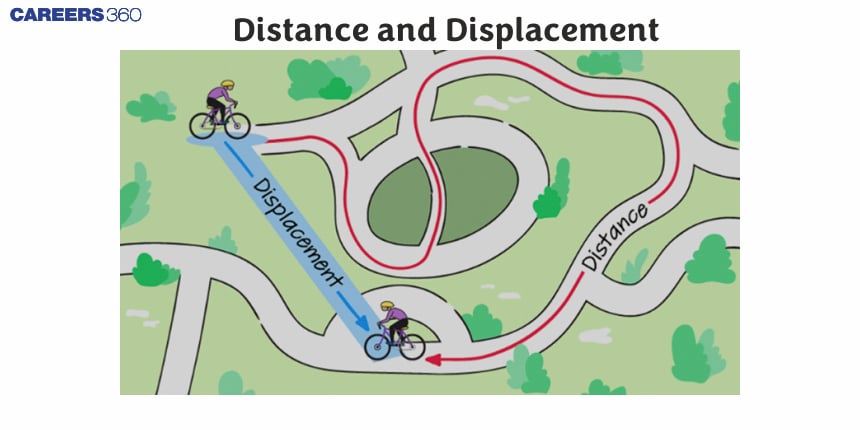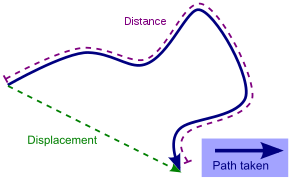Distance and Displacement - Definition, Examples, Difference, FAQs
Distance and displacement are very much used to describe the motion of an object. Distance is defined as how much ground an object has covered during its movement. It gives the total length of the path travelled without regard to any direction. Displacement, on the other hand, tells how far the object is from its starting point, along with the direction. It is the shortest way from start to end. Distance and displacement thus bear significance in studying motion clearly. In this article, we shall see their meanings and some differences, along with some easy examples.
This Story also Contains
- What is Distance?
- What is Displacement?
- Similarities of Distance and Displacement Difference
- What is the Difference Between Distance and Displacement?

What is Distance?
Distance is the total length of the path covered by an object while moving from one place to another. It tells us how much ground an object has covered during its journey.
Notes:
- Distance is a scalar quantity (it has only magnitude, no direction).
- It is always positive.
- It depends on the path taken.
- The SI unit of distance is meter (m).
Example:
If you walk around a park and cover 500 meters, your distance travelled is 500 meters, no matter the direction.

For example, If an object is moving from point O to Q then the path length will be equal to distance $OQ=240 \mathrm{~m}$.

The distance is a scalar quantity. It has only magnitude and no direction.
Also, check-
What is Displacement?
Displacement is the shortest straight line path between the initial and final position.
- Displacement is a vector quantity (it has both magnitude and direction).
- It can be positive, negative, or zero.
- It depends only on the initial and final positions, not on the path taken.
- The SI unit of displacement is meter (m).
For example, if A particle is moving from point P to O then the displacement of the particle is given by:
Displacement $(S)=$ position of point $O-$ Position of point $P=0-360=-360 \mathrm{~m}$
The negative sign shows the direction of the displacement.

Similarities of Distance and Displacement Difference
There are some parallels between distance and displacement difference that you should be aware of-
-
The difference in distance and displacement units is the same in S.I. units, namely meters (m).
-
Both measurements necessitate the use of a reference point.
-
If the motion of the object is in a straight line and in a single direction, they are equal.
-
Both distance and displacement have the same dimensions.
What is the Difference Between Distance and Displacement?
Here is the difference between Distance and Displacement. These are scalar and vector quantities respectively
| Sl. No. | Different properties | Distance | Displacement |
| 1. | Definition | The distance between any two points is the total length of the path. | The direct length between any two points measured along the shortest path between them is called displacement. |
| 2. | Denotation | d | s |
| 3. | Direction Consideration | The direction is ignored when calculating distance. | The direction is taken into account when calculating displacement. |
| 4. | Quantity | The magnitude, not the direction, determines the value of a scalar quantity. | Because it depends on both magnitude and direction, displacement is a vector quantity. |
| 5. | Route Information | The term "distance" refers to the specific route information used when travelling from one location to another. | Because displacement only refers to the quickest way, it does not provide entire route information. |
| 6. | Formula | speed × time | velocity × time |
| 7. | Possible values | Only positive numbers can be used in the distance. | Positive, negative, or even zero displacement is possible. |
| 8. | Measurement in non-straight path | A non-straight path can be used to calculate the distance. | Only a straight road may be used to quantify displacement. |
| 9. | Indication | An arrow does not represent distance. | An arrow is always used to denote displacement. |
| 10. | Path dependence | The distance is determined by the path followed, and it varies depending on the way taken. | Displacement is independent of the path and solely depends on the body's initial and ending positions. |
These are the key distinctions between distance and displacement difference that can aid in making a clear distinction between the two. These differences in distance and displacement, presented in tabular form, can help students remember the ideas more easily.
Frequently Asked Questions (FAQs)
The metre is the SI unit of measurement for distance.
The metre is the SI unit of displacement.
CGS units of measurement are centimetres.
The term "distance" refers to "how much ground an object has covered" during its travel.
The units of displacement and distance which are both same that is meters in standard unit. They both requires reference point in order to measure from initial point.